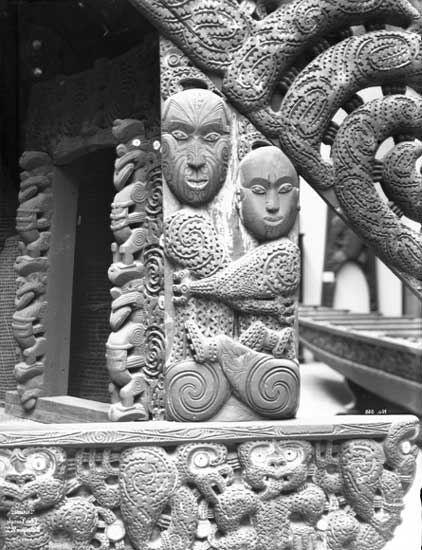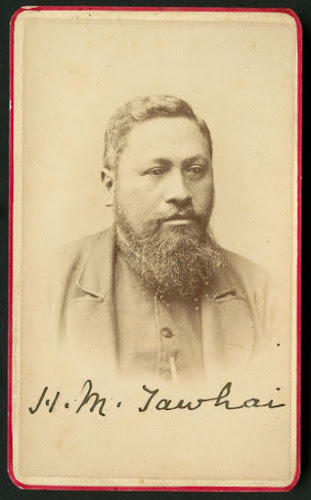On Writing History, Colonization and Development in New Zealand between 1769 and 1900: The Seeds of Rangiatea
By
Ian Pool, Emeritus Professor, University of Waikato
Vincent O’Malley has generously made space
available to me for a guest-blog in his series. I should mention, even before I
start, that I owe a lot to Vincent’s patient responses to my questions and
other forms of help in writing my book.
Marching into the specialised territory of
real historians is always a challenge for those of us who are on the fringes of
the discipline. In New Zealand this is
particularly true, as Aotearoa has a significant corpus of powerful historical
research – focused, technical monographs on many topics; elegantly written general
narratives in the best humanities’ traditions; and broader annales-type studies. In sum, I owe a large debt to historians.
Above all, historians have carefully documented the 19th century,
for example , its prime and momentous events, the key actors and their actions,
the constitutional trends, the interactions of Pākehā and Māori (albeit mainly
from Pākehā records), and so on. Additionally, also from the “outfield”,
Richard Boast’s legal history is an authoritative voice on the policies and
mechanics of Māori land loss. Much, of course, remains to done, and I hope that
my book stimulates this.
My research covers three axes: (i) population,
(ii) development and (iii) their broader contexts. For the third of these I turned,
with confidence, to the extant history by the “conventional historians”, as represented by my blog-host’s own work both
on pre- and post-Waitangi issues. This,
I thought, would be the easiest and most enjoyable aspect of my work. When I
last drew systematically on historical research for my 1991 book Te Iwi Maori, I was impressed by what I had
found. But the world had changed since 1991 – for the worse. Instead of a fast
and comfortable passage, I have had to navigate through waters churned up by
what I have called “tabloid historians”.
In its place “tabloidism”, making
history popular, is no bad thing, but also it must adhere to standards set by
the discipline.
Perhaps inspired by the American neo-con
“culture war” or the revisionist Australian “history wars”, we have seen a wave
of “historical” studies that have emphasised the lurid, very often
inaccurately, particularly for the pre-Waitangi period. These “histories” rely
on selected European sources. William Jennings seems to be that rare and
patient author who has read 2000 documents of the Marist Brothers in mid-19th
century French; “tabloid histories” even seem to by-pass a treasure trove of
first-hand observations in the 1838 Report
of the Select Committee of the House of Lords. By contrast, Victorian sources,
often written well after Waitangi by people who had not been there but seemingly
accepted uncritically by “Tabloidists”, often demonised Māori to justify their
displacement and deprivation, arguing that the British were not responsible. Moreover,
“Tabloidists” and their mentors – read Keith Windschuttle on Anne Salmond, a scurrilous
and inaccurate attack – avowedly eschew Māori sources as “unreliable”. Unfortunately, as Bain Attwood found when he
confronted Windschutle – that so-called “John
Howard intellectual” – documenting a detailed rebuttal is a tedious process. Thus,
I thought long and hard before I took on this challenge. Finally, I did so for
three reasons:
1. “Tabloidists” throw population data
around with a total lack of care and little knowledge about what are drivers,
and what are the maxima and minima of reported demographic trends – that is, what
is feasible: I had the tools to set the record straight and felt obliged to do
so (see below).
2. “Tabloidist” soundbites and other
pronouncements unjustly demonise Māori as stone-age “savages” – contrasting
them with a “superior race”, the British.
They were were busily “clearing” the Scots and Irish from their lands, brutally
putting down the Indian Mutiny and about to use Maxim guns on Mahdi’s poorly
armed cavalry at Omdurman, a slaughter applauded by young Winston Churchill. Unfortunately,
these notions have entered the public dialogue, right up to the highest levels
– one only has to think of Key’s comments in 2014, to say nothing of Don Brash’s,
Paul Holmes’, Michael Laws’ and others.
3. Perhaps most importantly, the attention
of the thinking public has been drawn away from the “everyday story” of Māori
life, especially pre-1840. Tumult and savagery are the profiled events. Yet, most
Māori were in fact engaged in “the factors
of production and reproduction”. Even the emblematic and terrible “Musket Wars”
were spotty in terms of geographic distribution and periodicity, probably more
significant for population redistribution than for lethality. Here I was
fortunate in having access to Ron Crosby’s incredibly detailed book; Michael
King’s endorsement of Crosby is truly justified. Crosby also carefully
cross-checked my parsing of his book – a very generous act. Despite one
“tabloidist” arguing that from 1850 Māori benefited from a Pax Britannica, the
New Zealand Wars, especially those of the 1860s, were both highly lethal and
caused massive displacements, besides finally destroying most of Māori
commercial horticulture. Moreover, from a military standpoint as James Belich
has shown, the British resorted to massive force: 27% of all Imperial troops
outside Britain and India were in New Zealand at one stage, far outnumbering
the Māori warriors pitted against them, and engaging in all the actions that
were to characterise colonial wars (eg “scorched earth” tactics in the Urewera
in the late 1860s). Even modest protest – the 1899 Rawene Dog Tax “War” – saw
military might (eg a naval ship, machine guns) brought to bear. And the attack
on pacifist Parihaka by 1600 armed militia and police, led by the Native
Minister, Bryce, must be New Zealand’s lowest moment.
To analyse Māori population trends I have
drawn on well-tested methodologies (empirically as well as mathematically),
grounded in demographic theory, plus the vast knowledge-base about how
population dynamics and structures change over time, including what are limits
to demographic trends. For dynamics (births and deaths), the so-called
“indirect estimation techniques” of demography are robust and very useful. They
are employed across the entire Third World to gain basic vital rates where data
are inadequate, and thus the statistics used for almost all macro-level social
and economic planning. But the rates merely provide skeletons, allowing
hypothesis-building. I hope these postulates will be investigated in depth
using the tools of expository research, particularly by historians with access
to the “iwi” and “hapu” books written in Māori in the 19th century.
This becomes even more important when one
turns to the third aspect of my work: development. I have explored this mainly
using secondary sources. But, until there is detailed expository analysis, my
research on what “Mr and Mrs Everyday Māori” were doing in the 19th
century must remain speculative. Despite the tumult of the inter-tribal wars
and other dislocations due to contact and by the invasion of pathogens, against
which Māori had no previous exposure and thus no resistance, everyday life continued
and, in some ways, Māori prospered. Māori adopted and adapted new foods, tools
and other technologies: I call these “clip-ons” to their economic system. But,
they also built on their own skills and structures, such as the trading
networks from the far north to the far south. By 1840 they were at a “take-off
point” for serious development. They also brought a very tangible, huge dowry
to the Waitangi Treaty table – all their land, their economy and their vibrant
international trading ventures. What did the British bring? Intangible
advantages of joining the British Empire?
This bring me to the end of my story. By
1897 (Queen Victoria’s Jubilee), Māori were in an “under-development trap”.
They were barely surviving because of introduced disease. This was, of course,
an unintended consequence of contact and colonisation. Given the state of 19th
century health sciences, even had they wanted to, the settlers had no real
means of improving Māori health. But the
gradual natural gains in resistance through exposure to disease were delayed for
Māori because of the “development of [their] under-development” by their brutal
displacement from their major capital base – land (to use Thomas Piketty’s
definition of capital). But Māori did not have access to the financial capital that
could allow them to escape this trap.
The sequel, which I am now working on, will
explore their “escape”, first by improved survival, and later, but only partially,
by building an asset base.
[Colonization and Development in New Zealand between 1769 and 1900: The Seeds of Rangiatea is published by Springer]



Comments
Post a Comment